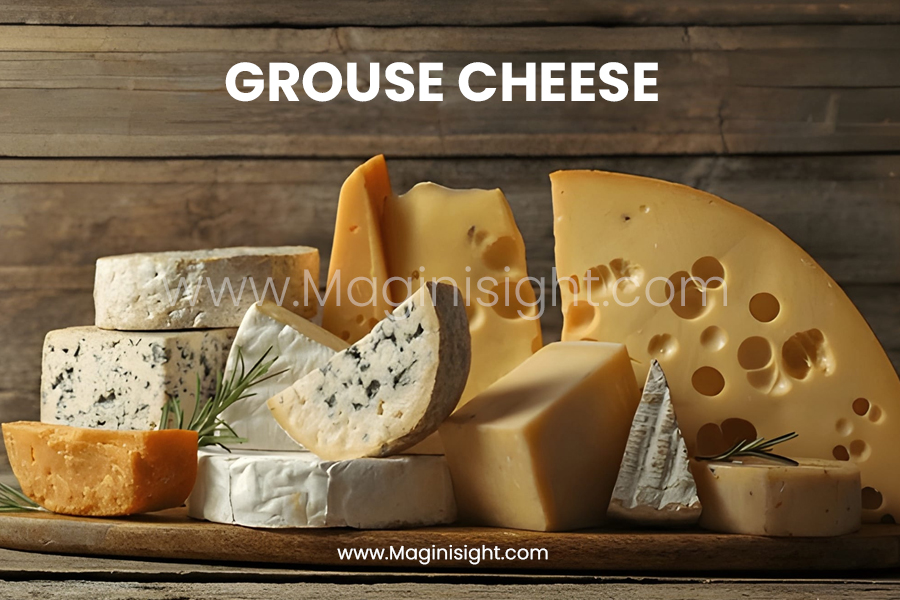If you are searching for something truly unique to bring depth to your meals, grouse cheese is an ingredient worth discovering. With its rich, earthy taste and subtle game-like undertones, this cheese is unlike anything you’ll find on a typical grocery store shelf. Food enthusiasts love it for its balance of boldness and refinement, while chefs appreciate its versatility in both traditional and modern cooking.
Grouse cheese isn’t just a cheese—it’s an experience that adds heritage, craftsmanship, and extraordinary flavor to your plate. In this complete guide, we will explore every detail about grouse cheese, from its origins and flavor profile to health benefits, storage, recipes, and cultural significance.
What Is Grouse Cheese?
Grouse cheese is a specialty variety often linked with artisanal traditions, crafted with precision and respect for time-honored cheese-making techniques. Unlike mass-produced cheeses, grouse cheese is typically made in smaller batches, giving it a character and quality that reflects both the land and the people who create it.
The name itself hints at a connection to the natural world, suggesting influences from rustic countryside traditions where game and cheese often share the table. It is commonly described as semi-soft to firm in texture, with an aging process that deepens its complexity over time. The result is a cheese that offers a taste of craftsmanship, heritage, and the environment in which it is made.
Origins and Background
The history of grouse cheese is rooted in regions where game birds like grouse were an integral part of local cuisine. These areas often had a strong culture of dairy production as well, creating the perfect conditions for innovation. Over time, cheesemakers began experimenting with unique techniques to complement the flavors of game meat, giving rise to what we now call grouse cheese.
While there is no single place to pinpoint as its birthplace, it is widely recognized as a product born out of a desire to pair cheese with rustic, hearty meals. Its evolution into a distinct category reflects not only culinary curiosity but also cultural traditions where resourcefulness was key.
How It’s Made
The production of grouse cheese follows the traditional steps of cheese-making—curdling, draining, pressing, and aging—but with extra care and often a longer maturing period. High-quality milk, usually from grass-fed cows, goats, or sheep, serves as the foundation. Cheesemakers then use a combination of rennet and natural cultures to form the curd.
What sets grouse cheese apart is the precise aging environment, which may include specific temperature and humidity levels that enhance its distinctive flavor. Some artisans even incorporate aging techniques passed down for generations, ensuring that every wheel of grouse cheese carries a signature taste. The attention to detail is what transforms ordinary milk into this extraordinary gourmet product.
Unique Qualities That Set It Apart
What makes grouse cheese stand out is its ability to blend earthy notes with creamy richness. While many cheeses focus on tang, sweetness, or sharpness, grouse cheese has an almost gamey complexity that appeals to adventurous palates. The aroma is robust without being overpowering, and the texture ranges from smooth and pliable to slightly crumbly, depending on how long it has aged.
These qualities make it a versatile addition to both rustic dishes and refined culinary creations. Unlike common cheeses that blend into the background, grouse cheese has a presence on the plate—it demands attention, sparks conversation, and leaves a lasting impression.
Flavor Profile of Grouse Cheese
When tasting grouse cheese, one immediately notices its layered complexity. At first bite, the creaminess provides comfort, but as it lingers, earthy undertones begin to reveal themselves. Some describe the flavor as slightly nutty, with a hint of wild herbs that reflect the natural environments associated with grouse.
The richness is balanced rather than overwhelming, making it suitable for both cheese connoisseurs and newcomers seeking something new. Unlike blue cheese, which can be sharp and divisive, grouse cheese delivers boldness without alienating the palate. This makes it a perfect conversation starter at gatherings and an excellent ingredient for chefs aiming to create memorable dishes.
Texture and Aroma
The texture of grouse cheese depends on its stage of aging. Fresh or young versions tend to be semi-soft, offering a creamy bite that pairs well with fruits and light wines. As the cheese matures, it becomes firmer, with small crystalline textures forming, giving each bite an added crunch and complexity.
The aroma is equally important—it ranges from mild and grassy in younger varieties to robust and earthy in aged ones. When placed on a cheese board, grouse cheese immediately stands out, not only for its distinct look but also for the inviting scent that hints at the flavors to come.
Comparing Grouse Cheese to Other Cheeses
Here’s a simple comparison table highlighting the strengths and potential drawbacks of grouse cheese:
| Feature | Grouse Cheese | Regular Cheese |
|---|---|---|
| Rich, earthy flavor | ✅ | ❌ (often milder) |
| Unique artisanal craftsmanship | ✅ | ❌ (mostly mass-produced) |
| High in protein and calcium | ✅ | ✅ |
| Lower lactose due to aging | ✅ | ❌ (can cause discomfort) |
| Versatile for cooking and pairing | ✅ | ✅ |
| Easily available in supermarkets | ❌ | ✅ |
| Generally more expensive | ❌ | ✅ |
| Shorter shelf life if artisanal | ❌ | ✅ (longer shelf life) |
Health Benefits and Nutritional Value
Cheese has always been a valuable part of human diets, and grouse cheese is no exception. It offers a balance of indulgence and nutrition, making it both a treat and a source of essential nutrients. Like many artisanal cheeses, grouse cheese is often made from high-quality milk, which retains more vitamins and minerals than heavily processed alternatives.
1. Protein and Calcium Content
Grouse cheese is rich in protein, a nutrient essential for repairing tissues and supporting muscle health. Each serving delivers a solid portion of this macronutrient, making it an excellent addition for those who want to increase their daily intake without relying solely on meat. It is also high in calcium, supporting bone density and overall skeletal strength. Regular consumption of calcium-rich foods like grouse cheese can contribute to long-term bone health, which is especially important as we age.
2. Vitamins and Minerals
Beyond protein and calcium, grouse cheese contains vitamins A, B12, and D, all of which support vital functions such as vision, energy metabolism, and immune response. Minerals like zinc, phosphorus, and magnesium are also present in significant amounts, giving grouse cheese a nutrient profile that goes beyond flavor alone. This makes it a functional food—one that nourishes the body while satisfying the taste buds. For people looking for foods that offer both pleasure and health, grouse cheese delivers on both fronts.
3. Digestibility and Lactose Factors
One of the advantages of traditionally aged cheeses like grouse cheese is that they often contain lower levels of lactose compared to fresh dairy products. The aging process breaks down much of the lactose, making it easier to digest for people with mild sensitivities. While it may not be suitable for those with severe lactose intolerance, it can be an option for many who usually struggle with dairy. Combined with its nutritional profile, this makes grouse cheese a wholesome choice for a wide audience.
Culinary Uses of Grouse Cheese
One of the most exciting aspects of grouse cheese is its versatility in the kitchen. From simple cheese boards to elaborate gourmet recipes, it adapts seamlessly to various contexts. Its flavor is bold enough to stand alone yet balanced enough to complement other ingredients without overpowering them. For both professional chefs and home cooks, grouse cheese opens the door to creativity.
1. Cooking with Grouse Cheese
In cooking, grouse cheese melts beautifully, creating a creamy texture that enhances dishes like risotto, pasta, or gratins. It adds depth to sauces, giving them an earthy richness that pairs well with mushrooms, roasted vegetables, and poultry. Even a small amount can transform an ordinary recipe into something extraordinary. Because of its complexity, chefs often use grouse cheese sparingly, allowing it to shine without overwhelming the dish.
2. Best Pairings (Meats, Wines, Fruits, and Breads)
Pairing is where grouse cheese truly shines. Its earthy profile makes it a natural match for roasted meats, particularly poultry and game like grouse itself. On a cheese board, it pairs beautifully with dried fruits, figs, and nuts, while rustic breads bring out its hearty qualities. When it comes to wine, grouse cheese is versatile—it complements both reds with earthy notes and crisp whites that cut through its richness. The ability to pair well across categories makes it a staple for dinner parties and gourmet experiences.
3. Grouse Cheese in Fine Dining vs. Home Cooking
In fine dining, grouse cheese is often highlighted as a centerpiece, whether in a tasting menu or as part of an artisanal cheese course. Its unique qualities make it a conversation piece for diners seeking new experiences. At home, it is equally valuable, elevating everyday meals into something special. Whether added to a sandwich, melted into a sauce, or presented on a cheese board, grouse cheese has the rare ability to make ordinary meals feel indulgent.
Recipes Featuring Grouse Cheese
1. Classic Grouse Cheese Platter
A grouse cheese platter is the simplest yet most effective way to enjoy this specialty. Combine slices of grouse cheese with crusty bread, seasonal fruits, and a drizzle of honey for balance. Add some nuts and a glass of wine, and you have a sophisticated yet approachable appetizer.
2. Grouse Cheese and Mushroom Risotto
The earthy notes of both grouse cheese and mushrooms make this dish a natural pairing. As the risotto cooks, fold in grated grouse cheese for a creamy texture and a flavor that complements the umami of mushrooms perfectly. This recipe turns a classic Italian dish into a unique culinary experience.
3. Grouse Cheese Stuffed Chicken
For a main course, try stuffing chicken breasts with grouse cheese and herbs. As the chicken bakes, the cheese melts inside, creating a juicy and flavorful filling. Paired with roasted vegetables or a light salad, this dish is both elegant and comforting.
4. Vegetarian Grouse Cheese Delights
Vegetarians can also enjoy grouse cheese in dishes like baked eggplant, stuffed peppers, or vegetable casseroles. Its earthy richness adds depth to plant-based recipes, proving that gourmet flavor doesn’t have to rely on meat.
Cultural and Regional Importance
Grouse cheese holds a special place in culinary culture. It reflects the traditions of regions where rustic cooking and artisanal craftsmanship have long gone hand in hand. Historically, it was not just a food but a way of preserving milk for times when fresh supplies were scarce. Over the years, it evolved into a symbol of quality and care, representing the connection between land, people, and food. Today, it continues to embody these values while adapting to modern tastes and techniques.
1. Traditional Uses
In traditional settings, grouse cheese was often paired with hearty meals after long days of work in the fields or countryside. It served as both sustenance and comfort, bringing people together around the table. This cultural role continues today, reminding us that food is not only about nutrition but also about community and heritage.
2. Modern Interpretations
Modern chefs are reinventing grouse cheese in innovative ways, using it in fusion cuisine, gourmet burgers, and even desserts. Its ability to complement both savory and sweet elements makes it a favorite for experimentation. This adaptability ensures that grouse cheese will remain relevant in global gastronomy for years to come.
Buying and Storing Grouse Cheese
For those new to grouse cheese, knowing how to buy and store it is essential. Unlike mass-produced cheeses, artisanal varieties require more care to maintain their flavor and texture. Learning these basics ensures that every bite is as enjoyable as intended.
1. How to Select Quality Grouse Cheese
When purchasing grouse cheese, look for varieties from reputable cheesemakers or specialty stores. High-quality versions will have a rich aroma, firm texture, and natural rind. Avoid cheeses that appear overly dry or have an unpleasant smell, as these may indicate poor storage. Whenever possible, taste before buying to ensure the flavor matches your preference.
2. Proper Storage Tips
To preserve grouse cheese, wrap it in wax paper or parchment before placing it in the refrigerator. This allows it to breathe while protecting it from excess moisture. Avoid storing it in plastic wrap for long periods, as this can trap moisture and alter the flavor. For longer storage, consider investing in a dedicated cheese box or container that maintains optimal humidity.
3. Shelf Life and Preservation
The shelf life of grouse cheese depends on its age at purchase. Young cheeses typically last one to two weeks, while aged versions can last up to a month if stored correctly. Always check for changes in smell, texture, or mold growth before consumption. By handling it with care, you can extend its enjoyment and reduce waste.
Grouse Cheese in the Future of Food
As global interest in artisanal foods grows, it is well-positioned to become a sought-after delicacy. Consumers are increasingly drawn to authentic, handcrafted products that tell a story, and grouse cheese fits this trend perfectly. Its unique qualities, cultural roots, and versatility make it a strong candidate for international recognition.
1. Trends in Artisan Cheese Making
The rise of small-batch cheese producers worldwide has sparked a renaissance in cheese culture. Grouse cheese, with its distinctive flavor and heritage, aligns with this movement. Cheesemakers are experimenting with new techniques, creating variations that appeal to modern tastes while staying true to tradition.
2. Sustainable Practices
Sustainability is becoming a key consideration in food production, and many makers of it prioritize eco-friendly methods. From sourcing milk from grass-fed herds to using renewable energy in production, these practices ensure that the cheese not only tastes good but also supports the planet. This commitment adds another layer of value for conscientious consumers.
3. Global Popularity and Demand
While once a regional specialty, grouse cheese is gaining recognition worldwide. Food festivals, culinary competitions, and online platforms have introduced it to new audiences. As more people seek unique dining experiences, the demand for grouse cheese is likely to grow, cementing its place in the future of global gastronomy.
Conclusion
Grouse cheese is far more than just another type of cheese. It is a celebration of tradition, flavor, and craftsmanship that bridges the gap between rustic authenticity and modern innovation. From its earthy taste and nutritional value to its versatility in the kitchen, grouse cheese offers something for everyone—whether you’re a gourmet chef, a casual foodie, or someone simply curious about new flavors.
Adding grouse cheese to your kitchen not only elevates your meals but also connects you to a broader cultural story of artisanal food. With its growing popularity and enduring charm, there has never been a better time to explore the world of grouse cheese.
Don’t miss out on any news—keep in touch for real-time information, visit Mag Insight







